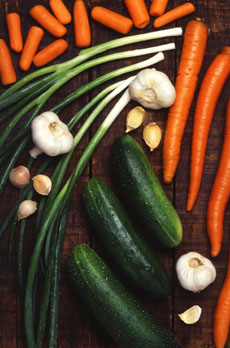TIP OF THE DAY: How To Revive Wilted Vegetables & Herbs
|
|
Sometimes, you bring vegetables home from the store and find them wilted the next day.
Other times, you forget about the vegetables for days, then find them wilted. This tip helps you revive asparagus, bell peppers, carrots, celery, greens, lettuce, scallions, zucchini and much of what you’d put on a crudité plate. Vegetables wilt when they dry out. You can restore the moisture with an ice bath: Fill a bowl with water with ice cubes. Add the vegetables (cut as you plan to use them) and let them sit for 15 minutes or longer. Remove with a slotted spoon or tongs and drain on a cloth or paper towel. Voilà: Your soft veggies are now crisp veggies, thanks to a chemical process known as turgor pressure.* IT WORKS FOR GRILLING, TOO Before you grill them, put your vegetables in an ice bath. When they come off the grill, they’ll be moist and crisp. |
|
|
HOW TO PREVENT VEGETABLES FROM WILTING IN THE FIRST PLACE Refrigerators have crispers to help vegetables remain fresh in a moister environment; the drawers trap moisture and slow the dehydration. Some crisper drawers have controls that regulate the moisture level in the crisper. If your crisper has settings, make sure to choose “Vegetables.” Fruits prefer less moisture rather than more: That’s why there are separate drawers for fruits and vegetables. If there’s no more room in the crisper, store the vegetables in plastic bags or containers. Mushrooms should be stored in paper bags or wrapped in paper towels, rather than stored in plastic. Remove any plastic wrap from a carton of mushrooms and replace it with paper. What Not To Put In The Fridge
|
||



